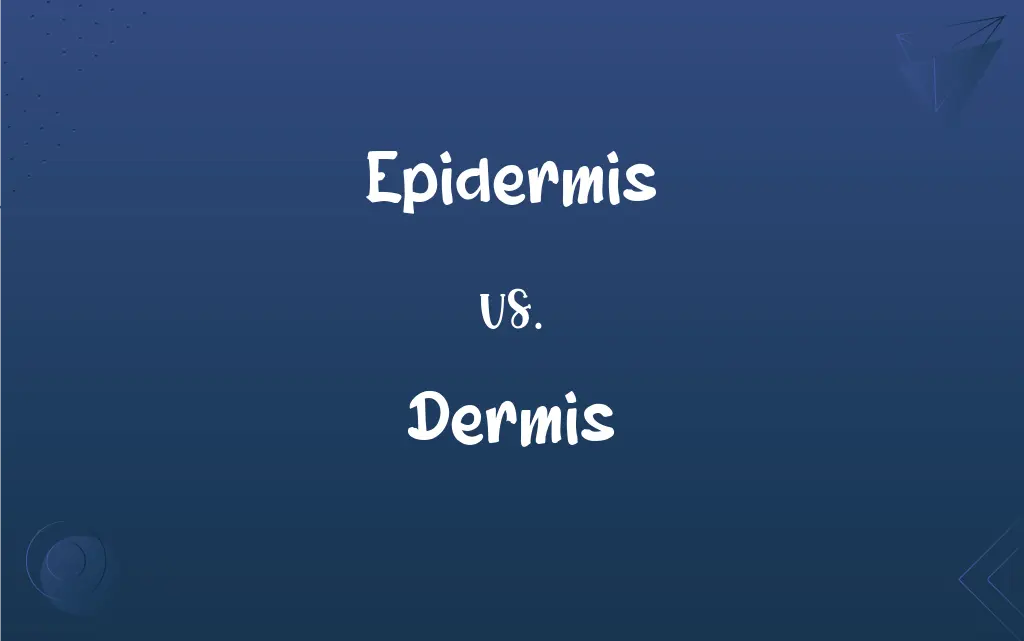Epidermis vs. Dermis: What's the Difference?
Edited by Janet White || By Harlon Moss || Updated on October 16, 2023
The epidermis is the outermost layer of the skin, providing a protective barrier, while the dermis is the inner layer housing blood vessels, nerves, and glands.

Key Differences
The epidermis and dermis are both integral components of the skin, but they serve distinct roles and have varied structures. The epidermis is the skin's outermost layer, acting as the primary shield against the external environment. It helps prevent water loss, keeps out pathogens, and contributes to the skin's overall appearance. In contrast, the dermis lies beneath the epidermis, providing strength and elasticity to the skin through its collagen and elastin fibers.
Within the epidermis, one can find multiple sub-layers, including the stratum corneum, which consists of dead skin cells that constantly shed and are replaced. The epidermis also houses melanocytes, cells responsible for producing melanin, the pigment that gives skin its color. The dermis, on the other hand, is packed with blood vessels, nerve endings, sweat glands, and hair follicles. These elements in the dermis are essential for sensation, temperature regulation, and providing nutrients to the skin.
The epidermis, being the skin's frontline, is predominantly responsible for protection. It guards against UV radiation, pathogens, and mechanical injuries. The dermis, however, plays a pivotal role in ensuring the skin remains nourished, flexible, and capable of sensing the surrounding environment.
A notable aspect of the epidermis is its ability to regenerate swiftly, thanks to its basal cells. When an injury occurs, the epidermis can often repair itself without leaving a scar. The dermis, given its complex structure and vital components, when injured, might not regenerate as efficiently, potentially resulting in scar tissue.
Comparison Chart
Location
Outermost layer of skin
Layer beneath the epidermis
ADVERTISEMENT
Function
Protection against external factors
Provides strength, elasticity, houses vessels and nerves
Cellular Components
Keratinocytes, melanocytes
Fibroblasts, blood vessels, nerve endings
Sensitivity to Injury
Can regenerate swiftly without scarring
Damage might lead to scar tissue
Thickness
Thinner and varies across body areas
Thicker and consistent
Epidermis and Dermis Definitions
Epidermis
The skin's primary barrier against environmental factors.
Lotions can moisturize the epidermis, keeping it hydrated.
ADVERTISEMENT
Dermis
The thick layer of skin located beneath the epidermis.
Tattoo ink is injected into the dermis to ensure its permanence.
Epidermis
The surface layer of cells on plants and animals.
The epidermis of the cactus has a waxy coating to prevent water loss.
Dermis
The region responsible for the skin's elasticity and strength.
Collagen in the dermis provides the skin with its firm structure.
Epidermis
The outer protective layer of the skin.
The sun's UV rays can damage the epidermis, leading to sunburn.
Dermis
The skin layer containing blood vessels, nerve endings, and glands.
When we touch something hot, the nerve endings in the dermis alert us.
Epidermis
The layer of the skin where new cells form and rise to the surface.
The epidermis constantly renews itself, shedding old cells.
Dermis
The layer of skin that nourishes the epidermis above it.
Blood vessels in the dermis supply nutrients to the overlying epidermis.
Epidermis
The skin region containing melanocytes that determine skin color.
Freckles are concentrated areas of melanin in the epidermis.
Dermis
The skin portion housing hair follicles and sweat glands.
When we sweat, the liquid originates from glands located in the dermis.
Epidermis
The outer, protective, nonvascular layer of the skin of vertebrates, covering the dermis.
Dermis
The sensitive connective tissue layer of the skin located below the epidermis, containing nerve endings, sweat and sebaceous glands, and blood and lymph vessels. Also called corium, cutis, derma1.
Epidermis
An integument or outer layer of various invertebrates.
Dermis
(anatomy) The tissue of the skin underlying the epidermis.
Dermis
The deep sensitive layer of the skin beneath the scarfskin or epidermis; - called also true skin, derm, derma, corium, cutis, and enderon. See Skin, and Illust. in Appendix.
Dermis
The deep vascular inner layer of the skin
FAQs
Does the epidermis contain blood vessels?
No, it is avascular.
What is the epidermis?
The epidermis is the outermost layer of the skin.
What is the primary function of the epidermis?
To provide a protective barrier against the environment.
Is the epidermis thick or thin?
It's relatively thin, especially compared to the dermis.
How does the epidermis regenerate?
New cells form at the base and push older cells outward.
What gives the epidermis its color?
Melanocytes produce melanin, which determines skin color.
What cells are found in the dermis?
Fibroblasts, macrophages, and mast cells.
What fibers are present in the dermis?
Collagen and elastin fibers.
What's the primary function of the dermis?
It provides strength and elasticity to the skin and houses various appendages.
What cells make up the epidermis?
Keratinocytes, melanocytes, Langerhans cells, and Merkel cells.
Is the epidermis dead or alive?
The outer layer consists of dead cells, but the inner layers are alive.
Can the epidermis repair itself?
Yes, it constantly renews and repairs.
What is the dermis?
The dermis is the middle layer of the skin, located beneath the epidermis.
How does the dermis differ from the epidermis?
The dermis is thicker, vascular, and contains connective tissue.
What structures are housed in the dermis?
Blood vessels, sweat glands, sebaceous glands, hair follicles, and nerve endings.
How does the dermis receive nutrients?
Through its extensive network of blood vessels.
How does aging affect the dermis?
The dermis can thin out, leading to wrinkles and decreased elasticity.
Is the dermis sensitive to touch?
Yes, it contains nerve endings responsible for touch sensations.
Can the dermis regenerate?
It has limited regenerative ability, but can heal with scar formation.
How many layers does the epidermis have?
Stratum basale, stratum spinosum, stratum granulosum, stratum lucidum (in thick skin), and stratum corneum.
About Author
Written by
Harlon MossHarlon is a seasoned quality moderator and accomplished content writer for Difference Wiki. An alumnus of the prestigious University of California, he earned his degree in Computer Science. Leveraging his academic background, Harlon brings a meticulous and informed perspective to his work, ensuring content accuracy and excellence.
Edited by
Janet WhiteJanet White has been an esteemed writer and blogger for Difference Wiki. Holding a Master's degree in Science and Medical Journalism from the prestigious Boston University, she has consistently demonstrated her expertise and passion for her field. When she's not immersed in her work, Janet relishes her time exercising, delving into a good book, and cherishing moments with friends and family.































































